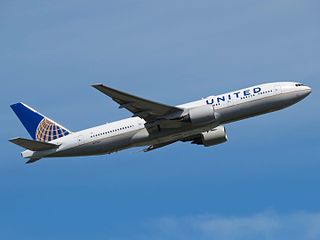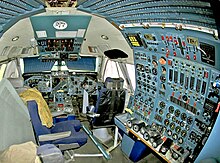
Avionics are the electronic systems used on aircraft. Avionic systems include communications, navigation, the display and management of multiple systems, and the hundreds of systems that are fitted to aircraft to perform individual functions. These can be as simple as a searchlight for a police helicopter or as complicated as the tactical system for an airborne early warning platform.

The Boeing 767 is an American wide-body aircraft developed and manufactured by Boeing Commercial Airplanes. The aircraft was launched as the 7X7 program on July 14, 1978, the prototype first flew on September 26, 1981, and it was certified on July 30, 1982. The original 767-200 entered service on September 8, 1982, with United Airlines, and the extended-range 767-200ER in 1984. It was stretched into the 767-300 in October 1986, followed by the 767-300ER in 1988, the most popular variant. The 767-300F, a production freighter version, debuted in October 1995. It was stretched again into the 767-400ER from September 2000.

The Boeing E-3 Sentry is an American airborne early warning and control (AEW&C) aircraft developed by Boeing. E-3s are commonly known as AWACS. Derived from the Boeing 707 airliner, it provides all-weather surveillance, command, control, and communications, and is used by the United States Air Force, NATO, French Air and Space Force, Royal Saudi Air Force and Chilean Air Force. The E-3 has a distinctive rotating radar dome (rotodome) above the fuselage. Production ended in 1992 after 68 aircraft had been built.

An aircraft pilot or aviator is a person who controls the flight of an aircraft by operating its directional flight controls. Some other aircrew members, such as navigators or flight engineers, are also considered aviators because they are involved in operating the aircraft's navigation and engine systems. Other aircrew members, such as drone operators, flight attendants, mechanics and ground crew, are not classified as aviators.

The McDonnell Douglas DC-10 is an American trijet wide-body aircraft manufactured by McDonnell Douglas. The DC-10 was intended to succeed the DC-8 for long-range flights. It first flew on August 29, 1970; it was introduced on August 5, 1971, by American Airlines.

Air Canada Flight 143, commonly known as the Gimli Glider, was a Canadian scheduled domestic passenger flight between Montreal and Edmonton that ran out of fuel on Saturday, July 23, 1983, at an altitude of 41,000 feet (12,500 m), midway through the flight. The flight crew successfully glided the Boeing 767 to an emergency landing at a former Royal Canadian Air Force base in Gimli, Manitoba, which had been converted to a racetrack, Gimli Motorsports Park. It resulted in no serious injuries to passengers or persons on the ground, and only minor damage to the aircraft. The aircraft was repaired and remained in service until its retirement in 2008. This unusual aviation incident earned the aircraft the nickname "Gimli Glider".

A cockpit or flight deck is the area, usually near the front of an aircraft or spacecraft, from which a pilot controls the aircraft.

A wide-body aircraft, also known as a twin-aisle aircraft, is an airliner with a fuselage wide enough to accommodate two passenger aisles with seven or more seats abreast. The typical fuselage diameter is 5 to 6 m. In the typical wide-body economy cabin, passengers are seated seven to ten abreast, allowing a total capacity of 200 to 850 passengers. The largest wide-body aircraft are over 6 m (20 ft) wide, and can accommodate up to eleven passengers abreast in high-density configurations.

The Boeing E-4 Advanced Airborne Command Post (AACP), the current "Nightwatch" aircraft, is a strategic command and control military aircraft operated by the United States Air Force (USAF). The E-4 series are specially modified from the Boeing 747-200B for the National Emergency Airborne Command Post (NEACP) program. The E-4 serves as a survivable mobile command post for the National Command Authority, namely the President of the United States, the Secretary of Defense, and successors. The four E-4Bs are operated by the 1st Airborne Command and Control Squadron of the 595th Command and Control Group located at Offutt Air Force Base, near Omaha, Nebraska. An E-4B when in action is denoted a "National Airborne Operations Center".

Aircrew, also called flight crew, are personnel who operate an aircraft while in flight. The composition of a flight's crew depends on the type of aircraft, plus the flight's duration and purpose.

A loadmaster is an aircrew member on civilian aircraft or military transport aircraft tasked with the safe loading, transport and unloading of aerial cargoes. Loadmasters serve in the militaries and civilian airlines of many nations.

Helios Airways Flight 522 was a scheduled passenger flight from Larnaca, Cyprus, to Prague, Czech Republic, with a stopover in Athens, Greece. Shortly after take-off on 14 August 2005, air traffic control (ATC) lost contact with the aircraft operating the flight, named Olympia; it eventually crashed near Grammatiko, Greece, killing all 121 passengers and crew on board. It is the deadliest aviation accident in Greek history.

USAir Flight 5050 was a passenger flight that crashed on takeoff from LaGuardia Airport in Queens, New York. As the plane took off from LaGuardia's runway 31, the plane drifted to the left. After hearing a loud bang, the pilots attempted to reject the takeoff, but were unable to stop the plane short of the end of the runway. The plane continued past the end of the runway and plunged into Bowery Bay. Two passengers were killed.

United Air Lines Flight 266 was a scheduled passenger flight from Los Angeles International Airport, California, to General Mitchell International Airport, Milwaukee, Wisconsin, via Stapleton International Airport, Denver, Colorado. On January 18, 1969, at approximately 18:21 PST, the Boeing 727 operating the flight crashed into Santa Monica Bay, Pacific Ocean, about 11.5 miles (18.5 km) west of Los Angeles International Airport, four minutes after takeoff, killing all 38 on board.

A Weapon Systems Officer (WSO), nicknamed "Wizzo", is an air flight officer directly involved in all air operations and weapon systems of a military aircraft.
The Future Air Navigation System (FANS) is an avionics system which provides direct data link communication between the pilot and the air traffic controller. The communications include air traffic control clearances, pilot requests and position reporting. In the FANS-B equipped Airbus A320 family aircraft, an Air Traffic Services Unit (ATSU) and a VHF Data Link radio (VDR3) in the avionics rack and two data link control and display units (DCDUs) in the cockpit enable the flight crew to read and answer the controller–pilot data link communications (CPDLC) messages received from the ground.

Flight envelope protection is a human machine interface extension of an aircraft's control system that prevents the pilot of an aircraft from making control commands that would force the aircraft to exceed its structural and aerodynamic operating limits. It is used in some form in all modern commercial fly-by-wire aircraft. The professed advantage of flight envelope protection systems is that they restrict a pilot's excessive control inputs, whether in surprise reaction to emergencies or otherwise, from translating into excessive flight control surface movements. Notionally, this allows pilots to react quickly to an emergency while blunting the effect of an excessive control input resulting from "startle," by electronically limiting excessive control surface movements that could over-stress the airframe and endanger the safety of the aircraft.

On February 13, 2018, around noon local time, a Boeing 777-222 airplane, operating as United Airlines Flight 1175 (UA1175), experienced an in-flight separation of a fan blade in the No. 2 (right) engine while over the Pacific Ocean en route to the Daniel K. Inouye International Airport (HNL), Honolulu, Hawaii. During level cruise flight shortly before beginning a descent from flight level 360, and about 120 miles from HNL, the flight crew heard a loud bang, followed by a violent shaking of the airplane, followed by warnings of a compressor stall. The flight crew shut down the failed engine, declared an emergency, and began a drift-down descent, proceeding direct to HNL where they made a single-engine landing without further incident at 12:37 local time. There were no reported injuries to the 374 passengers and crew on board and the airplane damage was classified as minor under National Transportation Safety Board (NTSB) criteria.

Airborne Express Flight 827 was a functional evaluation flight (FEF) of an Airborne Express Douglas DC-8-63F that had undergone a major modification. On December 22, 1996, during the test flight, the aircraft stalled and crashed, killing all six people on board. Accident investigators determined the cause of the accident was improper crew control inputs.

Tower Air Flight 41 was a scheduled domestic passenger flight from John F. Kennedy International Airport (JFK) in New York City, to Miami International Airport (MIA) in Florida. On December 20, 1995, the Boeing 747-100 operating the flight veered off the runway during takeoff from JFK. All 468 people on board survived, but 25 people were injured. The aircraft was damaged beyond repair and written off, making the accident the 25th hull loss of a Boeing 747. The National Transportation Safety Board (NTSB) concluded that the captain had failed to reject the takeoff in a timely manner.




















